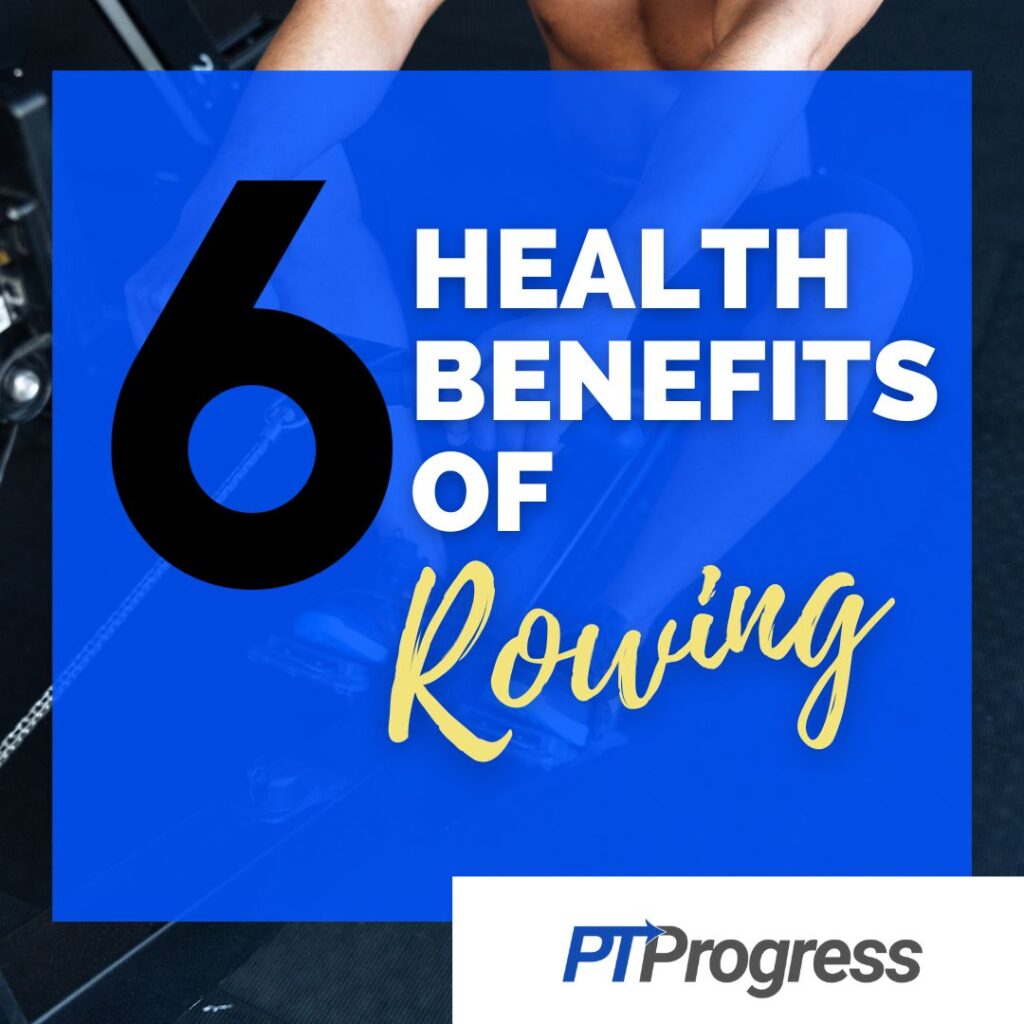
The benefits of rowing are myriad and immediate, making this form of exercise a no-brainer for people of all fitness levels. Keep reading for 6 reasons to row and an overview of the best machines on the market.
Intro to Rowing
Of all the at-home exercise equipment available, the rowing machine is easy to underestimate. Maybe you’ve watched someone at the gym tug on a rowing machine and wondered, how challenging can that be? Is it really worth the time and effort?
Despite its “gently-down-the-stream” appearances, rowing can provide a wealth of exercise benefits. Just 30 minutes of moderate rowing can rival, in calories and exertion, a steady run or exercise class. Rowing demonstrates that, to improve health and work up a sweat, you don’t need to pound pavement or pump iron. With rowing, all you need is good form, a range of resistance, and mental stamina to finish your workout.
Still unconvinced rowing is a good way to work out at home? Then consider the following 6 benefits of rowing.
6 Benefits of Rowing
There are arguably dozens of benefits to using a rowing machine, but here are six top reasons to row.
1. Rowing Improves Cardio Health

Rowing requires constant whole-body movement, which will get your heart pumping in no time. An elevated heart rate, when sustained for 30 minutes a day, 5 days a week, can help strengthen the heart and lungs. Right now heart disease is the leading causes of death in the United States. But regular cardiovascular exercise, such as rowing, can help lower blood pressure, improve heart metabolism and prevent coronary heart disease.
In fact, cardiovascular activities can have profound benefits on your entire body when performed regularly. Better cardio health has a ripple effect, helping you sidestep not just heart disease but also diabetes and obesity.
And the best news is that you can reap the benefits of cardio even if you’ve been sedentary most of your life. There’s never been a better time to put your heart health first, and there are few better ways to do that than rowing.
2. Rowing Burns Calories and Promotes Weight Loss

If your doctor has ever told you (hopefully gently!) to lose some weight, you might have assumed they meant hit the treadmill. After all, to lose weight, you need to create a caloric deficit and burn more calories than you consume. But running isn’t the only way to do that. Moderate rowing can burn calories at a comparable rate to jogging. Depending on your weight, fitness level, workout intensity, and other factors, by rowing you can burn anywhere from 400–1100 calories per hour.
As with any exercise, you should start slowly and build up the intensity. And to get more robust weight-loss results, consider changing your diet to reflect a healthier nutrient profile—more veggies, less sugar, and plentiful whole grains to help you feel fuller longer.
3. Rowing Targets Multiple Muscle Groups

The movement required to row engages multiple muscle groups, including your legs, back, torso, and arms. Each stroke begins with the “catch”—the start position, where your legs are fully bent and your arms outstretched in front of you, grasping the oars. From here, you straighten your legs and sit up straight to execute the “drive,” the bulk of the effort for each stroke. But the power isn’t only in your legs. For the “finish,” you’ll then bend your arms and pull the oars all the way to your chest. The “recovery” part of the movement—allowing your arms and then your legs to return to the start position—completes one stroke.
Catch, drive, finish, and recovery—each part of the stroke relies on a different combination of muscle groups for proper execution. With every stroke you take rowing, you’ll engage your lats, quads, hamstrings, abs, biceps, upper back muscles, and the muscles in your forearms. It’s hard to get this kind of comprehensive, full-body workout outside of swimming.
4. Rowing Is Low-Impact

Rowing is what we call a “low-impact” exercise, which doesn’t require jolting movement that could stress or strain joints. Unlike running, rowing provides a comprehensive cardio workout without taking a toll on your knee or hip joints. To get a good workout, you don’t have to pound pavement, climb steps, or jump rope. (Although there’s nothing wrong with high-impact exercise if your body can tolerate it!)
What’s more, rowing isn’t a weight-bearing exercise. The machine supports your weight, helping offload strained joints while still exercising them. If you’re overweight, that alone can significantly improve the exercise experience and stave off fatigue.
5. Rowing Can Support Injury Recovery

When you’re recovering from surgery or a musculoskeletal injury, there’s a limited variety of exercises you can perform safely. The last thing you want is to re-sprain your ankle, suffer a bad fall, or tweak your knee just as it was beginning to heal. But a low-impact, non-weight-bearing activity such as rowing makes exercise safer and more comfortable in general.
Many surgeons promote the benefits of rowing after procedures such as knee replacements, hip replacements, and ACL or meniscus surgeries. Of course, you’ll want to follow your PT’s recommendations for when it’s safe to start using a rower. You may need to modify your leg position while rowing to avoid excessive strain after surgery. For example, you can row with one leg off the rower to avoid bending that knee and hip and then gradually introduce a partial row as you gain range of motion and clearance by your PT and surgeon.
Don’t be tempted to skip exercise while you recover from an injury. Too often patients rely on “rest, ice, compression and elevation” for too long during the recovery process, though each of those components does play an important role. But to prevent muscle atrophy, promote beneficial blood flow, and speed the healing process, it’s imperative that you perform exercise appropriate for your injury. Always check with your doctor, surgeon, or physical therapist before jumping (literally or figuratively) into a new exercise. Chances are, they’ll recognize the benefits of rowing, even if you have to modify it. And that leads me to my last point…
6. Rowing Is Easily Modified To Be More or Less Challenging

People at all kinds of fitness levels can benefit from rowing. Whether you’re brand new to exercise or already a serious athlete, rowing can become the workout you need to take your fitness to the next level.
The challenge to rowing lies in the level of resistance you meet as you pull the “oars” towards your body. Depending on the type of rower, the resistance might be generated electromagnetically, or it might be the natural drag of pedals or a fan through water or air. You can easily adjust the level of resistance either by changing the settings or by adjusting the speed of your stroke, if you’re using a water rower. A lower resistance setting or a slower pace will lessen the challenge, while higher resistance or a quicker stroke can really make you break a sweat.
Once you’ve learned proper rowing technique and feel comfortable rowing with little resistance, introduce workouts that are progressively more challenging. Many rowers now feature display screens and built-in gaming software to help engage your attention, challenge your abilities, and push you to reach new goals.
Top 3 Rowers
Considering their many benefits, rowers are becoming tremendously popular. You can find them in a wide variety of styles, with an array of features and a range of price points. Below is an overview of three of the best-selling machines that can help you maximize all 6 benefits of rowing.
Concept 2 RowErg
- Air resistance
- Aluminum and steel construction
- Durable and low-maintenance
- Dimensions:
- Measures 96” x 24” x 14” (seat height), with optional risers adding 6” to seat height.
- Stores in two pieces to 25” x 33” x 54”
- Weighs 57 lbs, or 64 lbs with risers
- Fits users up to 38” inseam and weighing up to 500 lbs
- Includes free app for community and tracking data
- Costs $990 or $1155 with risers
Hands down, the most ubiquitous rower dotting fitness gyms, physical therapy clinics, and home basements all across the world is the RowErg from Concept 2. This machine uses air resistance through a flywheel to counter your movements, simulating the drag you’d experience rowing in water. Besides its simplicity and user-friendly design, you’ll love the resources available through their free app, including progress tracking, fun challenges, and a connected community of like-minded rowers.
Ergatta Rower
- Water resistance
- Handmade, cherrywood frame
- Smooth design emulates gliding through water
- Dimensions:
- Measures 86” x 23” x 12” (seat height), with optional risers adding 8” to seat height
- Folds up to 23” x 22.5” freestanding
- Weighs 76 lbs, or 106 lbs with water
- Fits users up to 40” inseam and weighing up to 500 pounds
- Membership gets you comprehensive gaming benefits
- Costs $2500, not including optional membership ($29/mo)
If you need to exercise at home but don’t want your house to look like a gym, then the Ergatta rower might be the perfect solution. Solidly built from beautiful Appalachian cherrywood, this machine is as easy on the eyes as it is on the joints, providing low-impact, vigorous exercise right in the heart of your home. Pay extra for an optional membership to their online community and you can enjoy thousands of programmed workouts, virtual games, and real-time racing.
You can read a more in-depth review of the Ergatta Rower here.
Hydrow and Hydrow Wave
- Electromagnetic resistance
- Aluminum and steel frame
- Immersive display and cutting-edge connectivity
- Dimensions:
- Measures 86” x 25” x 16.5” (seat height)
- Folds up to 25” x 33” x 47”
- Weighs 145 lbs
- Fits users with up to 36” inseam and weighing up to 375 lbs
- Hydrow Wave has a 30% smaller footprint, measuring 80” x 19” x 16.5” (seat height) and weighing 102 lbs
- Costs $2495 for Hydrow or $1895 for Hydrow Wave, not including required membership ($44/mo)
Hydrow has a way of thrilling the tech-minded among us. Whether it’s the stunning display, advanced app integration, or patented electromagnetic technology—this rower is sure to turn heads. Because the rowing resistance is generated magnetically, the machine runs uncannily quiet, making your every stroke smooth and silent. Unlike with Ergatta, membership to Hydrow’s online platform is required to use the rower, which may place this machine beyond your budget. If that’s the case, check out the Hyrdow Wave, their smaller, lighter and cheaper option.
Benefits of Rowing: Conclusion
Rowing packs a powerful punch, whether you’re looking to level up your at-home exercise or recover from an injury. It promotes overall health, provides potentially endless sources of workouts, and simplifies—without compromise—your approach to exercise. Start a rowing regimen, and you’ll discover many more benefits than the 6 on this list!

